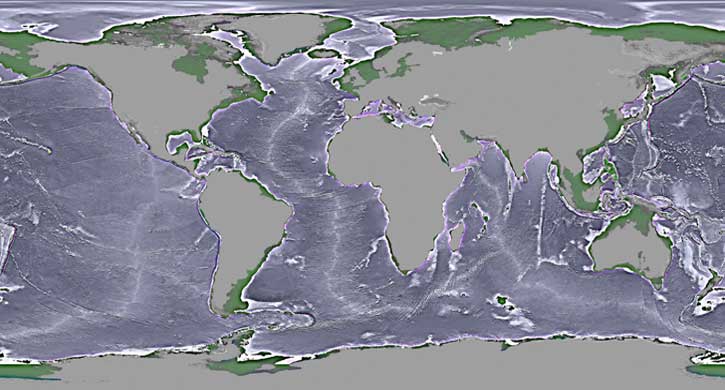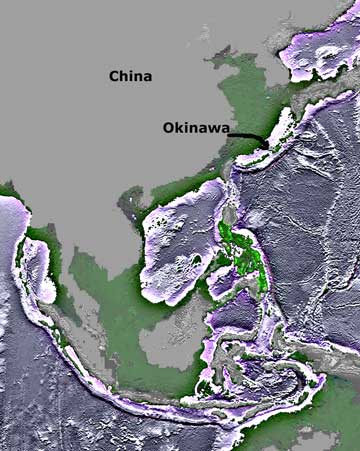|
As the sea-levels rose during the end of the last Ice Age, and the North Pole ‘shifted’ from its previous location at ’60 N’, ’73 W’ in the Hudson’s Bay area, to its current position, several million square miles of ‘prime habitable land’ were completely inundated on what are now the continental shelves and shallow seas of the Holocene world as we know it.
Geologists, now using sophisticated computer programs, can re-create the ancient sea-levels graphically, and so are able to pinpoint the areas of land that were above sea-level before the end of the last Ice Age. They have identified two specific periods of rapid sea-level risings at around 14,000 years ago and, most importantly, at around 11,600 years ago – at exactly the time that Plato gave for the inundation of the ancient civilisation he referred to as Atlantis.
It is interesting to note that since the discovery of the underwater structures around Yonaguni, and the advent of computer-generated sea level charts, some have claimed that here, in the South China Sea, is the ‘proof’ that the equally controversial ‘continent of Lemuria’ really once existed.
The image of global sea-level changes below was produced by Dale R. Bennett. The ‘grey’ areas are the current outlines of the dry land of the post-Ice Age period we now live in. Though in reality these times must be regarded as just another of the many ‘inter-glacial warm spells’ that have punctuated our planet’s natural state over millions of years.
a map of global sea-level changes since the last Ice Age

—
Dale R. Bennett
—
That natural state is an Ice Age, and the climate we enjoy at present is, in truth, nothing more than a ‘natural greenhouse effect’ – something we will have to learn to control and perpetuate if we want to keep on enjoying the benefits of the current global climatic conditions.
The areas in ‘green’ are the lands that were submerged in a series of ancient cataclysms as the glaciers melted, and the flood-waters poured into the Ice Age urban areas and inundated the trading-port settlements on the coastal plains of the ancient world. Only now are we beginning to re-discover the true reality of those archaic times as technological advances allow us to glimpse a more accurate view of the past.
But is this new view of the past anything like that described by Plato in his “Timaeus” and “Critias” dialogues, which first mention the cataclysms of antiquity, and the warnings given to Solon by an Egyptian priest about ancient records that spoke of:
… a deviation of the bodies that revolve in heaven around
the Earth and a great destruction, occurring at long intervals,
of things on the Earth by a great conflagration …
Given that any model of the prehistory of life, and human civilization, on our planet must take into consideration the history of the near-Earth environment, a recent theory for the ending of the last Ice Age seems to combine the known geological history of abrupt sea-level rises with the new appreciation of the periodic nature of celestial bombardment events on Earth.
The joint research of the late Sir Fred Hoyle and Chandra Wickramasinghe of the University of Wales at Cardiff, which proposes that an ocean impact of a comet-sized object was
the probable cause of the cataclysmic ending of the last Ice Age, has found a ready audience amongst those otherwise traditional academics who are beginning to listen to the arguments of the ‘Coherent Catastrophists’, whose numbers are growing daily.
The detail of the model proposes that a celestial body of sufficent volume to vaporise and eject billions of gallons of sea-water into the upper atmosphere, thereby causing an almost ‘instantaneous greenhouse effect’, impacted a major ocean around 12-13,000 years ago. Was that the Pacific Ocean?
Ice Age sea-levels showing the then dry land between
China, the Korean Peninsula, Okinawa and Japan

—
Dale R. Bennett
—
The survivors of those cataclysms who had managed to make it to the high ground and mountain-tops of the Ice Age world, today’s dry land, would have had to start all over again – right from scratch and very much on a ‘back to basics’ level foraging for food, seeking out clean potable water, and building rough shelters against the elements.
The amount of dry-land left in this epoch is approximately 29% of the total surface area of our planet. Is our whole view of prehistory, as we are taught in our schools, colleges and universities, based simply on the results of excavations of the sparse remains of those survivors’ efforts to survive on dry land as they watched the sea-levels rise with uncertainty and total dread?
If your world suddenly fell apart, and everything you’d previously taken for granted was gone, wouldn’t you shelter in a cave out of desperation, and maybe make it your base whilst hoping against all the odds that things might be ‘returned to normal’ again? And are the remains of these survivors those archaeologists today refer to as “Cave Men”?
Certainly, after one or two generations, those who had been born following the cataclysmic end of the previous way of life that had been brought to an abrupt end by the series of glacial outpourings, and consequent sea-level rises which continued for several millennia after the ‘event’ which triggered the end of the last Ice Age, would know only that about the anti-deluvian world which had been told them by their parents and grandparents.
As archaeologists come to terms with the concept that there was such a thing as ‘Ice Age Civilization’, and former Naval Forces-quality marine technologies filter through to academic usage, submarine ruins are being detecting in many areas of the world that was once dry land 10,000 to 15,000 years ago.
The use of sub-bottom profiling, and sidescan sonar is assisting in this major ‘paradigm-shift’, and should anyone ask why the myriad ancient stories about ‘lost lands’ and ‘sunken kingdoms’ have never been taken seriously by academia, perhaps the words of Plato can again give us a clue:
” … once more, after the usual period of years, the torrents
of heaven will sweep down like a pestilence, leaving
only the rude and unlettered among you … ”
History’s Mysteries
“Do undersea relics near Okinawa offer proof of a sophisticated civilization during the last ice age?
Archeologists have long believed that civilization as they define it — intelligent, tool-making, monument building, social humans — began about 5,000 years ago.
But submerged beneath the waves near the Japanese island of Yonaguni is evidence that may well overturn that long-held theory.
A small but persuasive number of scholars and scientists have long thought that “advanced” societies may have existed as long as 10,000 years ago.
Their theories, however well reasoned and defended, have been hamstrung by a lack of evidence.
But recent discoveries of man-made artifacts on the Pacific seafloor may well prove to be the smoking gun that will propel this alternative view of civilization to prominence”.
see the evidence with ‘unique underwater footage’
of the various Yonaguni structures in the
‘History Channel’ TV programme
“Japan’s Mysterious Pyramids”
DVD
or
VHS
|